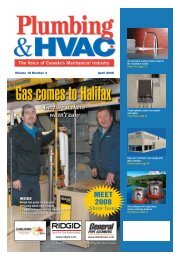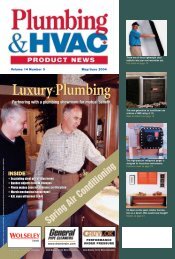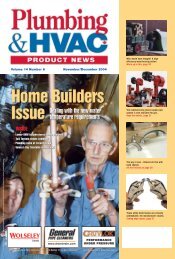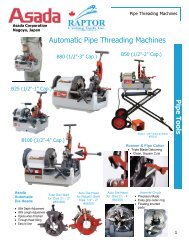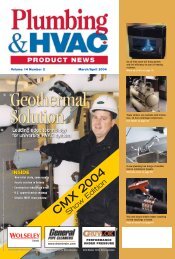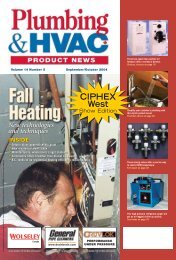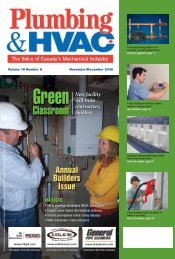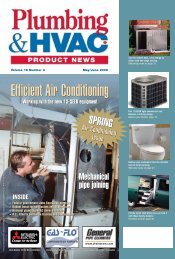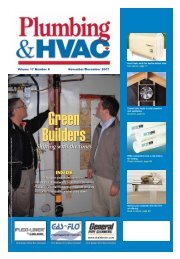March 2006 - Plumbing & HVAC
March 2006 - Plumbing & HVAC
March 2006 - Plumbing & HVAC
You also want an ePaper? Increase the reach of your titles
YUMPU automatically turns print PDFs into web optimized ePapers that Google loves.
HeatingSurvival of the fittestThe rocky road to efficient heating, ventilationBy Arthur IrwinLittle has beensaid regardingthe trials andtribulations encounteredthrough thepast thirty years byconsumers, builders,<strong>HVAC</strong> manufacturers, contractors andassociated trades. Yes, we have traveled aconsiderable distance and have mademany improvements in the varioustechnologies. But there are obstacles yetto be addressed.The energy crisisOur first energy crisis was born in theseventies, which caught consumers, energymarketers, <strong>HVAC</strong> equipment manufacturersand the building industry offguard. In the sixties, oil was nineteencents a gallon and there was no incentiveto insulate houses or seek a betterfurnace. Insulation products were poorperformers by today’s standards.In short, wewere all onthe learningcurve. Prior tothose years,oil-heatingapplianceswith efficienciesin thesixty percentrange wereperceived asbeing acceptable. Gas appliances generallylagged slightly behind in their levelof performance.A saviour? Possibly …In the late sixties, early seventies, a newconcept in combustion evolved in theU.S. oil burner marketplace. The introductionof the flame retention burner, aThe staining around this brickchimney is evidence of condensing.“That’s the good news,more efficient device with a cleaner,hotter flame, revolutionized the oil heatindustry. It produced energy savings ofup to 15 percent. Brookhaven NationalLaboratory in Upton, New York didconsiderable testing on the new conceptand by the mid to late seventies mostburner manufacturers had adopted thisnew concept.Driven by escalating oil prices and asa matter of survival, heating appliancemanufacturers were designing moreefficient heat exchangers for their boilersand furnaces as well. The end resultwas a much-improved combination ofburners and boilers or furnaces. That’sthe good news, but a nasty problemlater reared its ugly head.Yikes, condensing chimneys!Those old, inefficient heating appliancesproduced stack temperatures ashigh as 600-700°F, keeping those historic,outside brick chimneys warmduring thosebitterly coldnights as theyvented costlyheat up to theheavens.Enter theflame retentionconcept,a much moreefficient devicethat transfersmore heat into useful heat energyinstead of going up the chimney. Whenwe have low stack temperatures in the275-375°F range, the moisture in theexhaust gases rising in the chimneycondenses and falls out as a very corrosiveacid. This fluid can eventuallydestroy a conventional brick and mortarchimney and shorten the lifespan ofthe heating appliance. The high sulfurcontent in our heating oil greatly acceleratesthe corrosion.but a nasty problem laterreared its ugly head.”Stainless steel linersThrough considerable research, it wasfound that a stainless steel liner was thelogical solution. At this point, a numberof manufacturers had been producinginsulated, prefabricated metal chimneys.A number of these earlier typesfailed because the metal liner could notcompete with the acid attacking themetal. A higher quality stainless provideda solution.The chimney liner salvaged the brickchimney without disturbing the architectureof the structure. CSA developedstandards for proper sizing and installationprocedures. Sidewall venting alsobecame a successful option.Enter tighter homesAs we rolled into the eighties, many newtechniques in energy efficient homeA stainless steel liner prevents condensing in the existing chimney.construction were being developed.Insulation and air tightness was theobjective for the building envelope.Nobody foresaw a major problem causedby condensation resulting from poorventilation. Exterior walls in bedrooms,Mould on exterior walls is one of thefirst signs of insufficient ventilation.where cool surfaces were more common,often became the first indicatorsof mold and mildew that frequentlydestroyed exterior wall systems.Heat recovery ventilationThe early forms of mechanical ventilationconsisted of a packaged blowerunit that simply picked up stagnant air,usually from a central hall and or livingroom, and exhausted outdoors. Theseexhaust-only devices increased energyconsumption by as much as 20 percent.Better mechanical ventilation became amust.The improved HRV, in which theoutgoing, stagnant air partially preheatedthe incoming air, eventually evolved.It was a tough sell to builders, who arenow finally realizing that an HRV is amust in new homes.Frustrated consumersOne must recognize the fact there werecountless frustrated homeownersthrough the many years of research anddevelopment for these new developments.There were countless court battlesbecause of discontent between theconsumer, the builder and all tradesinvolved in the construction or renovationof homes.Things have improved, but there arestill testy moments between the tradesand homeowners. Problems evolvebecause nothing has been specified andthe consumer has no idea what isinvolved when changes take place.A large percentage of my industryinvolvement is acting as a heatingdesigner or building technologist forthe homeowner to prepare a specificationon which all trades can quote andavoid future surprises.Oil heat received a major boost inthe seventies with the developmentof the flame retention burner.The bottom line is that the old cliché“get it in writing” is for everybody’s protection.A few basic “job meetings,” withall players present, would eliminatemany future problems and hopefullyresult in a better product at the end ofday!Arthur (Art) Irwin operates Irwin EnergyConsulting Services in Halifax. He can bereached at irwin.a@ns.sympatico.ca.www.plumbingandhvac.ca February/<strong>March</strong> <strong>2006</strong> – <strong>Plumbing</strong> & <strong>HVAC</strong> Product News 19




